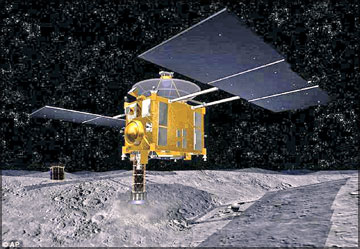|
After travelling four billion miles in seven years :
Space Explorer Returns
Chamari Senanayake
A Japanese space capsule called ‘Hayabusa
Explorer’ returned to Earth after a long seven-year, 4 billion mile
journey. This space capsule may contain the first ever-asteroid samples
that could provide clues into the evolution of the solar system.
Burning apart on re-entry to our atmosphere in a spectacular fireball
just after jettisoning, the capsule was recovered by a team of
scientists that flew in to Australian countryside on 15th of June.
|

The Hayabusa probe and its capsule zip across the sky near
Glendambo in southern Australia. Pic: AP. |
It was the first time a spacecraft successfully landed on an asteroid
and returned to Earth. Seiichi Sakamoto of the ‘Japan Aerospace
Exploration Agency’, which launched the explorer in 2003, said they were
‘delighted’ to recover the capsule, particularly after a number of
technical problems delayed Hayabusa’s arrival for three years. He added
that ‘Hayabusa’s arrival on earth is solely due to the fact that
scientists never gave up hope and worked on every technical difficulty
to get it back to earth.
Two helicopters took scientists to the capsule’s landing site in the
‘Woomera’ Prohibited Area, a remote military zone 300 miles northwest of
the South Australian state capital of Adelaide. The capsule and the
samples will be taken to Japan for study after a series of measures to
protect the capsule and its cargo.
‘Hayabusa’ reached an asteroid called Itokawa in 2005. After taking
photo images from all angles of the 1,640-foot long asteroid, ‘Hayabusa’
landed on it twice in late 2005, which was a great achievement for
science. The craft was originally designed to shoot a bullet into the
surface of the asteroid that would crush and propel material through a
long tube into a sample collection container. There is no certainty the
bullet actually fired, scientists say, but they believe the impact of
the tube’s landing would have forced some material upward and into the
collection chamber, and they have 50 percent chance of retrieving those
samples.
|

An artist’s impression shows the Hayabusa collecting space
material on the surface of Asteroid Itokawa. Pic: AP |
The Japanese space agency said the aim of the $200 million project
was to understand the origin and evolution of the solar system, as well
as paving the way for future sample return missions. Japanese scientists
also say that any samples from an asteroid, considered the building
blocks of planets, could also shed light on the origins of the Earth.
Scientists hope to study how and when the asteroid was formed, its
physical properties, what other bodies it may have been in contact with,
and how solar wind and radiation have affected it.
Hayabusa was originally due to return to Earth in 2007 but a series
of technical problems, including a deterioration of its iron engines,
some broken control wheels, and the malfunctioning of electricity
storing batteries forced it to miss its window to return into the
Earth’s orbit until this year.
If Hayabusa is indeed carrying any asteroid samples, it would be only
the fourth ‘space’ sample return in history. That includes moon matter
collected by the Apollo missions, comet material by Stardust, and solar
matter from the Genesis mission. |



